Study of Mexico’s Pre-libertad Silver Onzas (1949, 1978-1980)
by Scott Doll
Introduction
The silver Libertad is one of the most popular bullion issues from the Mexico City mint and has been released for sale every year since 1982 in various sizes ranging from 1/20 of an ounce up to one kilogram. It may be a surprise to some, but the Libertads were not the first silver bullion issue from the Mexico City mint. There is a predecessor one ounce silver bullion coin simply known as an “Onza” which was minted back in 1949 for only one brief year. It was then resurrected for a short three year period starting in 1978 and ending in 1980. The term Onza as the identifier for these issues is easily derived from the legend which states UNA ONZA TROY. The term stuck over time and became the de facto name referenced by most collectors. With that said, the Mexican public gave them another name of “Tejo” which in Spanish means a piece of silver or gold. Whatever the case, Onzas or Tejos have become more popular over time with the public and collectors alike and arguably they have proven they can hold their own in popularity and acceptance when compared to the Libertads.
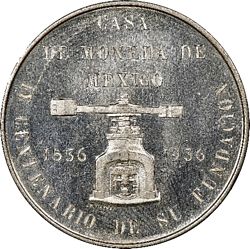
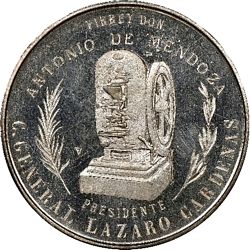
1936 Casa de Moneda Medal in Silver
Celebrating the 400th Anniversary of the Mexico City Mint
The story of the 1949 silver Onza actually began much earlier in 1936 when the Mexico City mint issued a commemorative medal which depicts as part of the obverse design a coining press used by the mint during the early part of the eighteenth century. This particular medal was issued in limited quantity in copper, silver and gold to celebrate the four hundredth anniversary of the Mexico City mint. Eleven years later in 1947 the mint used the same coining press design on the obverse of a crown-size one ounce silver pattern. The design for the reverse displayed a suspended balance scale which is a popular design feature on other Mexico 19th and 20th century coins. This particular coin was never released to the public with that date, but two years later in 1949 it was used in a similar silver bullion issue.
The year 1949 was a very busy time at the mint due to the devaluation of the peso which occurred during that year. The mint had been steadily decreasing the amount of silver used in the regular coin issues since the early part of the twentieth century and 1949 saw yet another decrease. By this time the public was missing their large silver coins and the mint somewhat obliged demand that year when the Banco de México requested that a crown-size coin with no denomination be struck in silver. This in turn satisfied public demand since it allowed them to purchase and store these large silver coins. The government was also satisfied since they were able to sell off large supplies of stored silver. The Mexico City mint had yet another purpose in mind for this issue as they were looking to increase revenue by highlighting the high quality and past performance of the mint to show other countries that they were capable of supporting their minting needs. By all accounts, the Mexican people, the mint (Casa de Moneda) and the government all benefited with this first year silver issue.
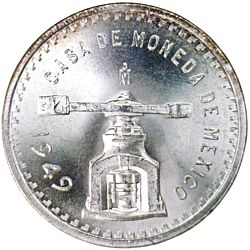
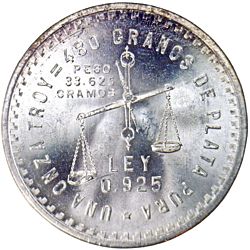
1949 Silver UNA ONZA TROY
Besides the coining press and the hanging balance scales, the other details of the coin highlighted the mint with the obverse legend of CASA DE MONEDA DE MEXICO (Mexico City mint), as well as the high silver content with the reverse legend of UNA ONZA TROY = 480 GRANOS DE PLATA PURA (one troy ounce of 480 grains of pure silver). The gross weight is somewhat more than an ounce due to other metals, predominately copper, contained within the planchet. The fineness of .925 (sterling silver) is higher than that used for any circulating Mexican coin at the time, therefore the Onzas were popular with anyone who wanted to buy and hold silver bullion. The reported mintage for the 1949 Onza is 1,000,000 pieces.
The original sale price in 1949 for these silver Onzas were reported to be the equivalent to $1 (US) and although this particular Onza design was minted for only one year, they were actively sold by banks in Mexico and other financial organizations around the world from 1949 up to 1961 when the price of silver soared, which caused the Mexican banks to suspend sales.
1978 Silver Onza
The mint resurrected the silver bullion Onza and began minting them once again in 1978 after a very lengthy absence of 29 years. The design of the 1978 issue is basically the same as that seen on the 1949 issue with the exception of the obverse and reverse legends. In fact, the obverse legend in 1978 has two distinct varieties. One legend variety has a wide spacing between the words CASA DE MONEDA DE MEXICO and narrow spacing between the letters while the other variety has a narrow spacing between the words and wide spacing between the letters. The specific mintage is not known for each specific legend variety, however the total mintage for the 1978 Onza is 280,000 which is significantly less than the 1949 issue.
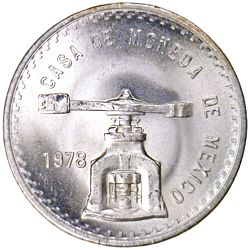
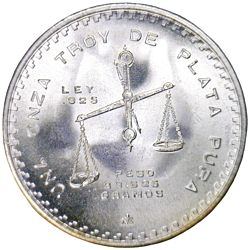
1978 Silver UNA ONZA TROY – Type 1
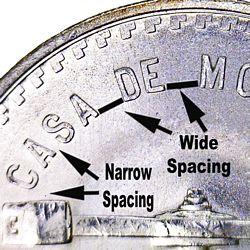
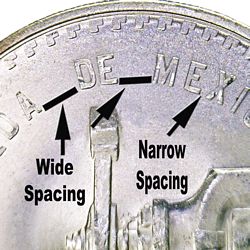
Type 1 – Wide spacing between the words and narrow spacing between the letters

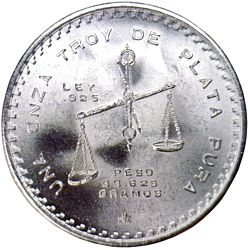
1978 Silver UNA ONZA TROY – Type 2
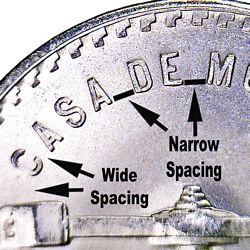
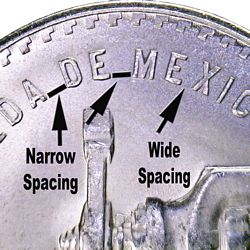
Type 2 – Narrow spacing between the words and wide spacing between the letters
1979 Silver Onza
The mint continued with the silver Onzas in 1979 with little change to the overall design with the exception on the reverse legend with the positioning of the left pan of the hanging balance scale. One variety (Type 3) points to “U” in UNA. The other variety (Type 4) points to the space between the “U” and the “N” in UNA. The specific mintage is not known for each variety; however the total mintage for the 1979 Onza is 4,508,000 which is significantly more than prior years combined.
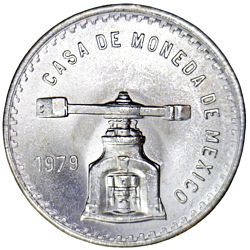
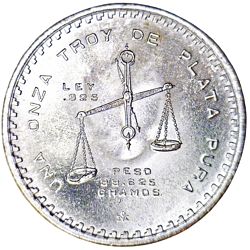
1979 Silver UNA ONZA TROY – Type 3
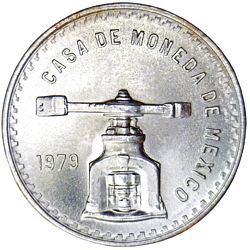

1979 Silver UNA ONZA TROY – Type 4
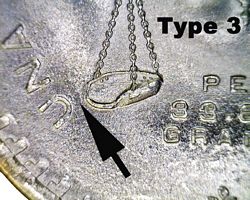
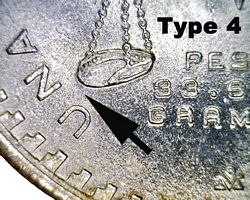
Type 3 – pan points to “U” Type 4 – pan points between “U” and “N”26
Type 3 Obverse Error
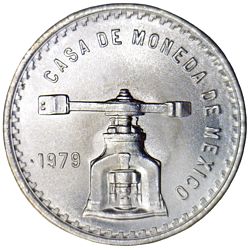
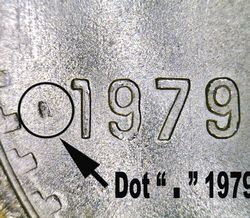
There is a die defect error worth noting for the 1979 Type 3 issue. This error shows a dot “.” before the date which is very similar to the popular Mexico dot “.” 1954 brass 5 centavos coin which is also the result of a die error.
1980 Silver Onza
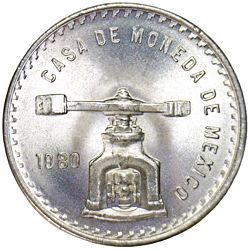

1980 Silver UNA ONZA TROY – Type 5
The final year for the Onza with the coining press design came in 1980. Although the overall design is basically the same as prior years, 1980 has something not seen with prior Onzas – overdates. There are at least four known overdate varieties, albeit some are very faint and arguably could be attributed to other things. All the same, these have been generally accepted by collectors as overdates and collected as such. 1980 also has several other date varieties to include slanting digits and high and low digits. The total mintage for 1980 is 6,104,000 which is once again more than all previous years combined.
Example #1 Date Alignment Error
There is several known date alignment errors in the 1980 issue. Example #1 shows a vertical “19” and a slightly slanting “80” in the date. The “0” in the date is also slightly higher compared to other digits.
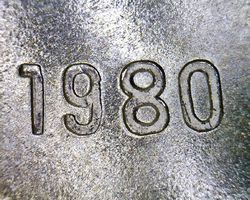
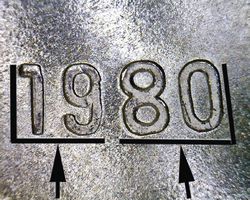
Example #1 1980 Onza with a vertical “19” & slanting “80” & high “0”
Examples #2.1 & #2.2 Date Alignment Errors
Examples #2.1 & #2.2 highlights two different Onza date varieties. Example #2.1 shows an Onza with a low “0” which is also slightly slanting to the right.
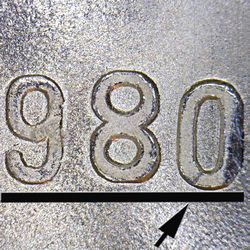
Example #2.1 1980 Onza with a low “0”
Example #2.2 shows a high vertical “0” (no slanting) in the date. All other date digits on both examples are evenly aligned and for the most part vertical.
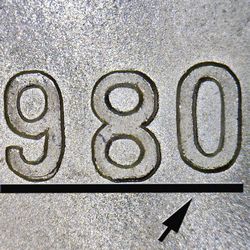
Example #2.2 1980 Onza with a high “0”
Examples #3 Overdate Error
Example #3 shows a very faint “8” over a “7” overdate. The top horizontal portion of the “7” can be seen across the top of the “8”, as well as across the top inner curve of the “8”. This bar is very faint and not easily discernible on the scan, but can be seen on an actual coin using a magnifier.
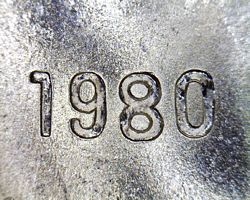

Example #3 1980/70 overdate - “8” over “7”
Examples #4 Overdate Error
Example #4 shows a 1980/79 overdate. The description for the “8” over “7” overdate is basically the same as Example #3. The “0” over “9” overdate can only be seen on a very small area at the upper outer left curve of the “0”. The “0” digit is vertical and evenly aligned with the other digits of the date.
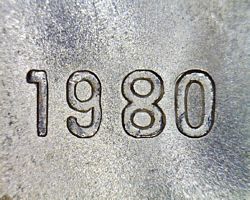
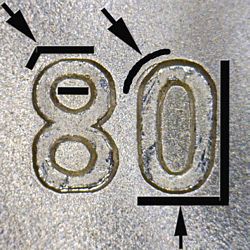
Example #4 - 1980/79 overdate – “80” over “79” with small overdate area
Example #5 Overdate & Doubling Error
Example #5 shows a 1980/9 overdate which is similar to Example #4 except the “8” over the “7” overdate is missing on this variety. This overdate example also shows a doubling on the “8” which is visible on the inner top portion of the digit, as well as the bottom side curves.
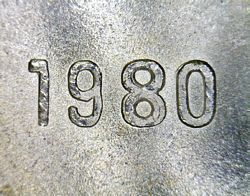
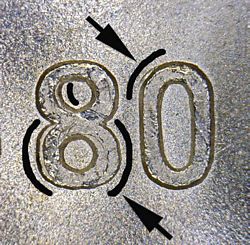
Example #5 - 1980/9 overdate - “0” over “9” with small overdate area & doubling on the “8” in the date
Example #6 Overdate Error
Example #6 shows a 1980/9 overdate which is similar to the previous 1980/9 overdate examples (#4 & #5) except this overdate covers a somewhat larger area on the coin surface. The “0” is also slightly slanting to the left compared to previous 1980/9 overdate example where the digit is more upright.
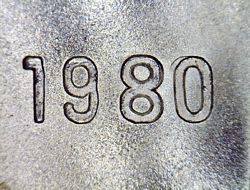
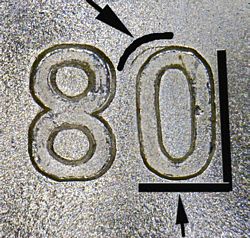
Example #6 - 1980/9 overdate - “0” over “9” with large overdate area
Scarcity and Summary
Overall, these Onzas are by and large common due to generally high mintages (approximately 12 million were minted with four different dates). With that said, some of the varieties listed can be a challenge to find and thus considered somewhat scarce. It is also important to note that the Onza varieties outlined within this article do not constitute a complete listing of the varieties since I am most certain there are more varieties waiting to be discovered and documented.
The values for the Onza generally fluctuate with the market price of silver bullion (currently around $20). Most Onzas on the market today can be easily purchased at reasonable prices through online auctions and at coins shows. Since the Onzas are normally seen with surface or bag marks, expect to pay a slight premium for a Brilliant Uncirculated (BU) coin with minimal marks.
A high grade, non-overdate or other non-date variety Onza in today’s market will generally sell for spot silver plus a 25-35% markup. However, there are some exceptions to this opinion. The first year Onza (1949) in BU will sell for about 2.5–3 x silver spot price, the various 1980 overdates and other date varieties will go anywhere 1.5–2 x silver spot price. The 1978 Type 2 Onza, which can be a challenge to find, will also go for approximately 1.5-2 x silver spot price.
Since many dealers do not take the time to classify the varieties within this Onza series, you might be surprised when you are able to pick up most dates and varieties for the same price as one of the common Onzas. A complete set of high grade Onzas outlined within this article should be able to be purchased for not a whole lot more money above silver bullion value as long as you are patient and look for the bargains.
